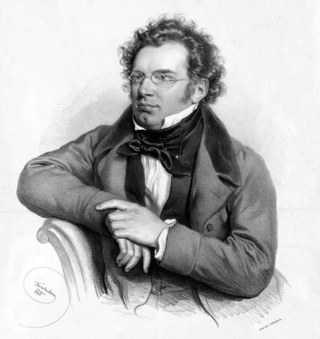Related Research Articles

Franz Peter Schubert was an Austrian composer of the late Classical and early Romantic eras. Despite his short life, Schubert left behind a vast oeuvre, including more than 600 secular vocal works, seven complete symphonies, sacred music, operas, incidental music, and a large body of piano and chamber music. His major works include the art songs "Erlkönig", "Gretchen am Spinnrade", and "Ave Maria"; the Trout Quintet; the Symphony No. 8 in B minor (Unfinished); the Symphony No. 9 in C major (Great); the String Quartet No. 14 in D minor ; the String Quintet in C major; the Impromptus for solo piano; the last three piano sonatas; the Fantasia in F minor for piano four hands; the opera Fierrabras; the incidental music to the play Rosamunde; and the song cycles Die schöne Müllerin, Winterreise and Schwanengesang.

Eduard von Bauernfeld, Austrian dramatist, was born at Vienna.

"Ellens dritter Gesang", in English: "Ellen's Third Song", was composed by Franz Schubert in 1825 as part of his Op. 52, a setting of seven songs from Walter Scott's 1810 popular narrative poem The Lady of the Lake, loosely translated into German.

An die ferne Geliebte, Op. 98, is a composition by Ludwig van Beethoven written in April 1816, setting poetry by Alois Jeitteles.

Alfonso und Estrella, D 732, is an opera with music by Franz Schubert, set to a German libretto by Franz von Schober, written in 1822. Along with the later Fierrabras, composed in 1823, it marks Schubert's attempt to compose grand Romantic opera in German, departing from the Singspiel tradition. Unlike Fierrabras, it contains no spoken dialogue.

"Heidenröslein" or "Heideröslein" is a poem by Johann Wolfgang von Goethe, published in 1789. It was written in 1771 during Goethe's stay in Strasbourg when he was in love with Friederike Brion, to whom the poem is addressed. The episode is the inspiration for Franz Lehár's 1928 operetta Friederike, which includes a setting of "Heidenröslein" by Lehár.

Im Frühling in G major is a Lied by Austrian composer Franz Schubert.

Franz Adolf Friedrich Schober, since 1801 von Schober, was a poet, librettist, lithographer, actor in Breslau and Legationsrat in Weimar.

Der Zwerg is a lied for voice and piano by Franz Schubert, written in the mid-1820s on a text by Matthäus von Collin. The poem is in terza rima. In Otto Erich Deutsch's catalogue of Schubert's works, it is Op. 22, No. 1, D. 771.

Rita Katherine Steblin was a musicologist, specializing in archival work combining music history, iconography and genealogical research.

Stabat Mater in F minor, D 383, is a musical setting of the Stabat Mater sequence, composed by Franz Schubert in 1816. It is scored for soprano, tenor and bass soloists, SATB choir, 2 flutes, 2 oboes, 2 bassoons, contrabassoon, 2 french horns, 3 trombones, violin I and II, viola, cello and double bass.
The Kaisermarsch is a patriotic march composed by Richard Wagner in 1871 in order to exalt the foundation of the German Empire after the victorious Franco-Prussian War.
Franz Schubert's best-known music for the theatre is his incidental music for Rosamunde. Less successful were his many opera and Singspiel projects. On the other hand, some of his most popular Lieder, like "Gretchen am Spinnrade," were based on texts written for the theatre.

Franz Schubert's best known song cycles, like Die schöne Müllerin and Winterreise are based on separate poems with a common theme and narrative. Other song cycles are based on consecutive excerpts of the same literary work: Schubert's "Ave Maria" is part of such a song cycle based on excerpts of the same poem, in this case by Walter Scott.

"Ständchen", D 889, is a lied for solo voice and piano by Franz Schubert, composed in July 1826 in the village of Währing. It is a setting of the "Song" in Act 2, scene 3 of Shakespeare's Cymbeline. The song was first published by Anton Diabelli in 1830, two years after the composer's death. The song in its original form is relatively short, and two further verses by Friedrich Reil were added to Diabelli's second edition of 1832.

Die Verschworenen, also known as Der häusliche Krieg is an 1823 one-act singspiel by Franz Schubert after a libretto by Ignaz Franz Castelli with spoken dialogue by the composer. Castelli's libretto was based on Lisistrata, ou Les Athéniennes, Comédie en un acte et en prose, mêlée de vaudevilles by François-Benoît Hoffman, which had premiered at the Théâtre Feydeau in Paris in 1802. The French play in turn was based on Lysistrata by Aristophanes.
Franz Schubert composed a number of works known as Ständchen, meaning serenade.
Marie Schönfeld was an Austrian government worker ("Regierungsassistentin") who became an anti-Nazi resistance activist.

"Gesang der Geister über den Wassern" is a 1779 poem by Johann Wolfgang von Goethe (1749–1832). It may be best known in the English-speaking world through a musical setting of 1820–21 by Franz Schubert (1797–1828) as a part song for men's voices and low strings (D.714).
References
- 1 2 3 Pegram, Robert Bruce. "Interpretative Analysis: "Who is Sylvia?" by Franz Schubert". Etude Music Magazine. Retrieved 10 February 2016.
- 1 2 3 4 5 Reed, John (1997). The Schubert Song Companion. Manchester, UK: Manchester University Press. p. 49. ISBN 9781901341003 . Retrieved 11 February 2016.
- ↑ Woodstra, Chris; Brennan, Gerald; Schrott, Allen (2005). All Music Guide to Classical Music. Backbeat Books. p. 1195. ISBN 9780879308650 . Retrieved 11 February 2016.
- ↑ Schubert's Werke, Serie XX: Sämtliche einstimmige Lieder und Gesänge, volume 8, 1823–1827, no. 505 (pp. 232–233), Leipzig: Breitkopf & Härtel, 1895, plate F.S. 866
- ↑ "Schubert – An Sylvia". Art Song Central. 29 May 2007. Retrieved 1 May 2020.
- ↑ Low, Peter (2016). Translating Song: Lyrics and Texts. Taylor & Francis. p. 104. ISBN 9781317246572.
- ↑ Brown, John Edwin; Sams, Eric (1990). The New Grove Schubert. W. W. Norton. ISBN 9780393315868 . Retrieved 11 February 2016.
